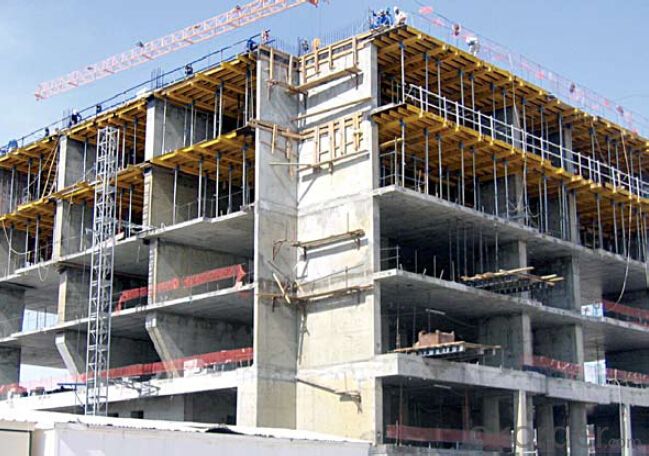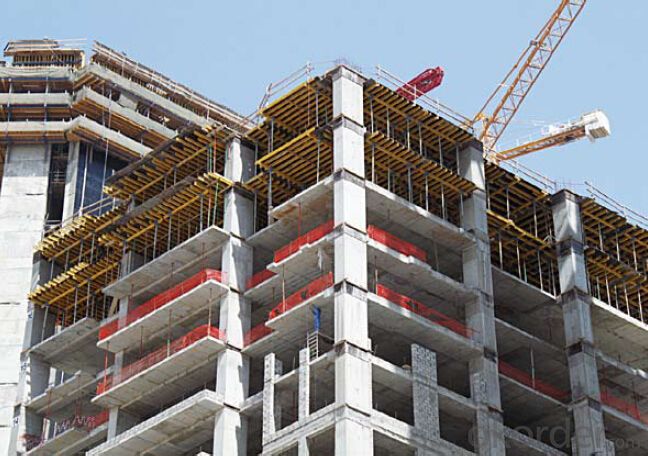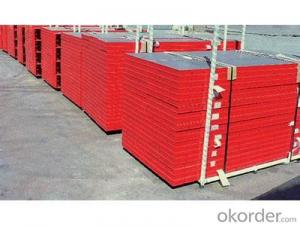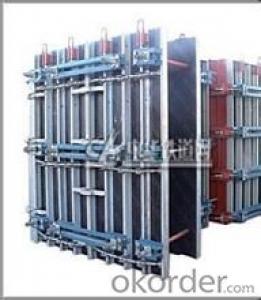Tabel formwork system
- Loading Port:
- China Main Port
- Payment Terms:
- TT OR LC
- Min Order Qty:
- -
- Supply Capability:
- -
OKorder Service Pledge
Quality Product, Order Online Tracking, Timely Delivery
OKorder Financial Service
Credit Rating, Credit Services, Credit Purchasing
You Might Also Like
Tabel Formwork:
Table formwork is the most typical application for slab, with timber beam, the slab formwork is
light weight, fast and economic in the construction.
Characteristics:
◆ Simple structure, easy assembly.
◆ Flexible structure, be adapted to different support system.
◆ High construction efficiency with special system tools.
1. Lifting fork for lifting the table formwork to upper floor.
2. Trolley for moving the table formwork on floor.
◆ Flexible application with stand alone props.
◆ Safer condition with handrails.



- Q:Can steel frame formwork be used in combination with post-tensioning techniques?
- Yes, steel frame formwork can be used in combination with post-tensioning techniques. Post-tensioning is a method used to reinforce concrete structures by placing steel tendons within the concrete and then applying tension to the tendons after the concrete has cured. This technique can help increase the strength and durability of the structure. Steel frame formwork, on the other hand, is a system used to create the temporary molds or forms into which concrete is poured to create the desired shape of a structure. It consists of steel frames, panels, and accessories that are assembled on-site. When using post-tensioning techniques, the steel tendons are usually placed within the concrete before the formwork is erected. The steel frame formwork can be designed and adjusted to accommodate the tendons and ensure that they are properly positioned within the concrete. Additionally, steel frame formwork provides the necessary support and stability during the post-tensioning process. The formwork system can withstand the forces generated by the tensioning of the tendons without deforming or collapsing, ensuring that the concrete remains in the desired shape and position. Therefore, steel frame formwork can indeed be used in combination with post-tensioning techniques, providing an efficient and effective solution for constructing reinforced concrete structures.
- Q:How does steel frame formwork handle the placement of architectural features and details within the concrete structure?
- Steel frame formwork is a versatile and efficient solution for incorporating architectural features and details into a concrete structure. Its sturdy and rigid structure ensures the accuracy and precision necessary for seamlessly integrating these elements. One of the main advantages of steel frame formwork is its ability to mold and shape concrete to match desired architectural features. Customization is easily achieved, allowing for the creation of intricate details and unique designs. Furthermore, steel frame formwork provides excellent support and reinforcement during the concrete pouring process. The strong steel frames prevent deformation or displacement of architectural elements, ensuring precise positioning and secure embedding within the structure. The precision and accuracy of steel frame formwork also contribute to the overall quality and aesthetics of the concrete structure. The reliable framework enables precise pouring, resulting in a smooth and uniform finish that enhances the beauty of the architectural features. Moreover, steel frame formwork offers time and cost-saving benefits. The modular nature of the steel frames allows for easy assembly and disassembly, reducing construction time and labor costs. This facilitates the efficient placement of architectural details within the concrete structure. In conclusion, steel frame formwork is essential for incorporating architectural features and details into a concrete structure. Its versatility, strength, and precision ensure visually stunning and structurally sound designs.
- Q:What is the expected lifespan of steel frame formwork?
- The expected lifespan of steel frame formwork can vary depending on several factors. Generally, steel frame formwork is known for its durability and longevity, making it a preferred choice for many construction projects. With proper maintenance and care, steel frame formwork can last for several years. The lifespan of steel frame formwork is influenced by factors such as the quality of the steel used, the level of usage, environmental conditions, and the regularity of maintenance. High-quality steel frame formwork that is manufactured to industry standards and undergoes regular inspections and maintenance can last anywhere from 10 to 20 years. However, in some cases, steel frame formwork has been known to last even longer when properly maintained. It is important to note that the lifespan of steel frame formwork can be significantly reduced if it is exposed to harsh environmental conditions, such as extreme temperatures or corrosive materials. Regular cleaning, rust prevention measures, and timely repairs can help extend the lifespan of steel frame formwork. In conclusion, the expected lifespan of steel frame formwork can range from 10 to 20 years or more, depending on factors such as quality, usage, maintenance, and environmental conditions.
- Q:Can steel frame formwork be used in combination with architectural concrete finishes?
- Combining architectural concrete finishes with steel frame formwork is indeed possible. By utilizing steel frame formwork, a robust and stable structure capable of withstanding the weight and pressure of the concrete can be achieved. Notably versatile, the steel frame formwork can be easily adjusted and modified to suit various architectural designs and shapes. To accomplish architectural concrete finishes such as exposed aggregate, polished, or textured concrete, employing steel formwork is essential. The use of steel formwork permits precise placement and shaping of the concrete, resulting in a sleek and visually appealing outcome. Moreover, the reusability of steel formwork makes it a cost-effective alternative for projects that necessitate architectural concrete finishes. Nevertheless, it is crucial to adequately prepare the steel frame formwork before applying architectural concrete finishes. This may entail applying a release agent or using form liners to create desired patterns or textures. By ensuring proper preparation and maintenance of the formwork, the desired architectural concrete finish can be achieved while preserving the integrity and durability of the steel formwork.
- Q:How does steel frame formwork handle the placement of reinforcement bars?
- Steel frame formwork is a construction system that utilizes a steel frame structure to support concrete during the pouring and curing process. When it comes to the placement of reinforcement bars, steel frame formwork handles it in a highly efficient and effective manner. Firstly, steel frame formwork provides a sturdy and rigid structure that can easily accommodate the placement of reinforcement bars. The steel frames are designed to securely hold the bars in place, preventing any movement or displacement during the concrete pouring process. This ensures that the reinforcement bars are properly positioned and aligned, which is crucial for the structural integrity of the concrete element. Secondly, steel frame formwork typically includes specially designed accessories and components that facilitate the placement of reinforcement bars. These accessories, such as steel bars holders, spacers, and connectors, are integrated into the formwork system to ensure that the bars are correctly spaced and supported. This allows for precise positioning of the reinforcement bars according to the specified design requirements. Furthermore, steel frame formwork often provides adjustable features that allow for easy customization of the reinforcement bar placement. These adjustable elements, such as movable brackets or adjustable connectors, enable the formwork system to accommodate varying bar sizes and configurations. This flexibility ensures that the reinforcement bars can be installed in the most optimal positions, considering factors such as load distribution and structural requirements. In addition to the technical aspects, steel frame formwork also offers advantages in terms of time and labor efficiency when handling reinforcement bars. The steel frames can be easily assembled and disassembled, allowing for quick and convenient installation of the reinforcement bars. This helps to reduce construction time and labor costs, making steel frame formwork a popular choice among contractors and builders. Overall, steel frame formwork provides a robust and versatile system for handling the placement of reinforcement bars. Its ability to securely hold and support the bars, along with its adjustable features and time-saving benefits, makes it an effective solution for ensuring proper reinforcement in concrete structures.
- Q:What type of concrete finishes can be achieved with steel frame formwork?
- With steel frame formwork, various concrete finishes can be achieved, including smooth surfaces, textured patterns, exposed aggregate, or even decorative finishes like stamped or stained designs. The steel frame formwork provides a sturdy and precise framework, allowing for the creation of different aesthetic effects and finishes on the concrete surface.
- Q:What are the advantages of steel frame structure
- Durability: light steel structure residential cold-formed thin-walled steel structure using all system components, steel using super anticorrosion high strength cold rolled galvanized sheet manufacturing, effectively avoid the influence of the steel in the construction and use of the process of corrosion, increase the service life of steel member. Structural life up to 100 years.
- Q:How does steel frame formwork contribute to the overall cost-effectiveness of a construction project?
- The cost-effectiveness of a construction project is enhanced by steel frame formwork in several ways. Firstly, the durability and longevity of steel allow for multiple reuses of the formwork, significantly reducing the need for frequent replacement. This results in substantial savings on formwork materials throughout the project's lifespan. Moreover, the high versatility of steel frame formwork enables easy adjustments and customization to meet specific project requirements. This flexibility facilitates efficient and accurate construction, reducing the time and effort needed for formwork installation and removal. As a result, labor costs are reduced, and construction schedules can be expedited, leading to overall cost savings. Furthermore, steel frame formwork ensures excellent stability and structural integrity, guaranteeing even and precise pouring of concrete. This minimizes errors and the need for rework, thereby reducing material wastage and associated costs. The precision and consistency provided by steel frame formwork also enhance the overall quality of the construction, reducing the need for future repairs or maintenance. Additionally, steel frame formwork is cost-effective due to its ease of transportation and assembly. The lightweight nature of steel components allows for easy transportation to the construction site, resulting in reduced transportation costs. Furthermore, the assembly process is straightforward, enabling quick setup and dismantling of the formwork, saving time and labor expenses. Lastly, steel frame formwork offers a high level of safety and stability during the construction process. The robustness of steel ensures that the formwork can withstand heavy loads and adverse weather conditions, minimizing the risk of accidents or delays. This not only protects workers but also avoids potential financial liabilities and disruptions to the project. In conclusion, the utilization of steel frame formwork in construction projects greatly enhances cost-effectiveness. Its durability, versatility, precision, ease of transportation, and safety features all contribute to reduced expenses on materials, labor, and maintenance. Through optimized construction timelines and minimized errors, steel frame formwork helps optimize project budgets and achieve successful outcomes.
- Q:Are there any safety precautions that need to be taken when using steel frame formwork?
- Yes, there are several safety precautions that need to be taken when using steel frame formwork. Firstly, it is important to ensure that the steel frame formwork is properly installed and secured to prevent any collapse or instability. This includes checking the connections and supports to ensure they are structurally sound. Additionally, workers should always wear appropriate personal protective equipment (PPE) such as helmets, safety glasses, gloves, and steel-toed boots to protect themselves from any potential hazards on the construction site. It is also crucial to follow the manufacturer's instructions and guidelines for the steel frame formwork to ensure it is being used correctly. This may include maintaining proper spacing and alignment of the formwork components and using the appropriate bracing and supports. Regular inspections of the steel frame formwork should be conducted to identify any signs of damage or wear. Any damaged or deteriorated components should be immediately replaced to maintain the integrity and safety of the formwork system. Furthermore, it is important to consider the weight and load-bearing capacity of the steel frame formwork. Overloading the formwork can lead to collapse or instability, so it is essential to adhere to the specified weight limits and distribute the load evenly. Finally, communication and coordination among the construction team are crucial when using steel frame formwork. Clear instructions and warnings should be given to everyone working in the area to ensure their safety. By following these safety precautions, the risk of accidents and injuries can be significantly reduced when using steel frame formwork.
- Q:What is the average time required for assembling and disassembling steel frame formwork?
- The average time required for assembling and disassembling steel frame formwork can vary depending on the size and complexity of the structure. However, in general, it can take anywhere from a few hours to a few days for experienced workers to complete the process.
1. Manufacturer Overview |
|
|---|---|
| Location | |
| Year Established | |
| Annual Output Value | |
| Main Markets | |
| Company Certifications | |
2. Manufacturer Certificates |
|
|---|---|
| a) Certification Name | |
| Range | |
| Reference | |
| Validity Period | |
3. Manufacturer Capability |
|
|---|---|
| a)Trade Capacity | |
| Nearest Port | |
| Export Percentage | |
| No.of Employees in Trade Department | |
| Language Spoken: | |
| b)Factory Information | |
| Factory Size: | |
| No. of Production Lines | |
| Contract Manufacturing | |
| Product Price Range | |
Send your message to us
Tabel formwork system
- Loading Port:
- China Main Port
- Payment Terms:
- TT OR LC
- Min Order Qty:
- -
- Supply Capability:
- -
OKorder Service Pledge
Quality Product, Order Online Tracking, Timely Delivery
OKorder Financial Service
Credit Rating, Credit Services, Credit Purchasing
Similar products
New products
Hot products
Related keywords
























